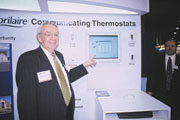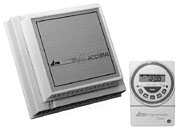
The problems come along when the product is mismatched to the customer. It could be a good match for the system, but unless the customer really understands how to use the stat, they may not get the benefits that you, the contractor, promised.
In addition to taking a little time to brief the homeowner on a thermostat’s operation, it’s important to know the variety of products from which to choose. This is a sampling of thermostats displayed at the AHR Expo here.

Contractor Marketing Aids
Quite a few products have features that not only help customers use the product, but also help contractors keep their name out there when it comes time to service the equipment. After all, some customers probably do think it’s the stat that isn’t working.PSG Controls (Perkasie, PA) offers E-Accustat AS Series programmable thermostats with comfort-economy temperature settings within the control. The control goes into the economy-comfort setting via a remote module, timer, or light, motion, or other sensor. The thermostat is available in single-stage heat and cool or two-stage heat and cool.
In addition, “Now the room thermostat can send that message to your customers when their hvac system needs to be serviced,” the company says.
PSG’s Medallion Service Watch can be set by contractors to remind the homeowner when the filter, air conditioner, and/or heater needs to be serviced. The contractor’s phone number appears on the display so the homeowner knows who to call. It can monitor filter, air conditioner, and heater run-hours; when those hours (preset by the contractor) are reached, the contractor’s phone number is displayed on the large LCD display. It continues to flash periodically.
Medallion models are also said to make programming easy.
Viconics (St. Leonard, PQ, Canada) tells end-users that “If you can say yes or no, you already know how to program our thermostat.” The T8000 Series offers programmable and nonprogrammable electronic PI (proportional-integral) thermostats.
The model features what the company calls “an intuitive, menu-driven, back-lit LCD screen which can be programmed by all users without any instruction sheets.” Multiple, built-in user profiles have been created for home, office, and retail structures. These can be enhanced or overridden using on-screen prompts.
“According to many industry studies on programmable thermostats, difficulty of use is the most important factor which restrains the growth of these products,” the company says. Visitors to the show were invited to put a wired model through its paces.
Upscale homeowners interested in electronics will appreciate Research Products Corp.’s (Madison, WI) Aprilaire® communicating thermostats. These units let end-users monitor, set, and control indoor heating and cooling functions from a PC, the company says.
The single-point, centralized control of multiple thermostats is suitable for structures with three or more thermostats and multiple heating and air conditioning units. Key to the system is the communicating thermostat, used in place of a standard thermostat. Each one is tied to a single control panel. They can also be used as standalone thermostats whether or not the computer is operating, the company says.
Benefits also include customized temperature adjustment for each area of a home or building; elimination of the need for “lock boxes”; temperature adjustment for work schedules and holidays; compatibility with remote access software to allow for off-site monitoring; and system flexibility.
The company also will imprint the dealer’s name and logo on its thermostats.

Tighter Tolerances
It’s a fact that some customers require tighter temperature tolerance due to process conditions.The Silicon Temperature Control (STC) from Therm-O-Disc, Inc. (Mansfield, OH), offers a solid-state approach to temperature control. The company says that the technology resulted from a study of those applications where tight temperature control is required.
The result is a thermostat designed for integrated temperature sensing and switching with reliability and accuracy, the company says.
The STC allows “open” and “close” temperature to be adjusted independently by changing the value of a single resistor. “The STC is inherently accurate because of the physical properties of the device.” Accuracies of ±1°C are achieved without the addition of sorting sensors, the company says.
While the STC is compatible with microprocessors, the company says it is not dependent on one to operate.
Refrigeration Technology Inc. (Middletown, CA) introduced the RTI Super Stat, which the company calls “the ultimate control for temperature and humidity.” It was designed to meet the needs of the refrigeration industry.
The surface- or panel-mount stat offers easy programmability, simple operation, min/max memory, high/low alarms, and a PC interface, the company says. The unit uses the Modbus protocol to provide control for coolers, wineries, chillers, wine cellars, food processing, freezers, damp environments, and breweries. The system is IBM-compatible with Windows-based software.
And Selco Products Co.’s (Orange, CA) WK Series thermostat, with a temperature range of -31° to 104°F and differentials from 4° to 10°, is said to offer smooth adjustment and high reliability for refrigeration, freezer, beverage cooler, and display case applications.
The thermostat is rated at 20 amps and features automatic reset, a selection of preset temperature ranges, and comes with mounting hardware such as brackets, terminals, dial plates, and adjustment shaft options.

Versatility, Flexibility
Finally, many thermostats offer a variety of options that make them applicable for a number of heating and air conditioning configurations. They also feature ease-of-use features that need to enter the product decision.Danfoss (Baltimore, MD) displayed its 6000 Series of electronic, programmable, 5/2-day heat-cool thermostats. The series combines the functions of a thermostat and time control in a “simple-to-use” unit. There are models for applications such as two-pipe changeover systems.
All models have a large LCD display that shows time or actual room temperature. Advanced programming options include a keyboard lock. Nonprogram-mable versions are also available. All heat-cool models incorporate dual setpoint adjustment so that heating and cooling temperatures can be set independently. An adjustable minimum deadband setting keeps heating and cooling settings from overlapping.
White-Rodgers’ (St. Louis, MO) Comfort-Set® 90 Series is a universal, staging residential-light commercial thermostat with system selectability between single-stage, multistage, and heat pump operation.
Perhaps more important to end-users, it also offers a lighted keypad for temperature adjustment during low-light conditions. “Anyone who’s ever gotten up in the middle of the night to adjust the temperature of their home will appreciate the lighted keypad,” said vice president of marketing Ron Miles.
Other features include seven independent-day programming, automatic heat-cool system changeover, and a menu-driven programming sequence. Up to three digital remote sensors can be installed up to 200 ft from the thermostat. Digital signals from individual sensors can be averaged or weighted by program time period.
The Robertshaw® 9555 2H/2C digital, nonprogrammable thermostat from Invensys (Long Beach, CA) offers backlit displays that are larger for enhanced readability, the company says. The model’s LED system indicators make it easier for homeowners to identify heating or cooling cycles “from across the room,” the company says.
Memory storage retains setpoints during power outages, and adjustable first- and second-stage differential “ensures a comfortable home at all times.” The model includes a feature that limits the adjustable temperature setpoints, and an adjustable fan delay. It is compatible with electric two-heat, two-cool furnaces and is equipped with O and B terminals for installation.
Lux Products Corp. (Mt. Laurel, NJ) introduced the Luxpro Series PSM30 (heating only), PSM33 (three-wire heat only), PSM40 (heating and cooling), and PSM50 (cooling only) thermostats which have an adjustable heat anticipator.
They are compatible with most 24-V gas, oil, and electric heating and air conditioning systems; two-wire hydronic systems; millivolt systems; hydronic air handlers; single-stage heat pumps; and three-wire hydronic systems (PSM33 only). They are not compatible with multistage heat pumps and 120- or 240-V systems.
Systems, Controls & Instruments’ (Pipersville, PA) TED Series 24-vac thermostats for hvac systems and fancoils offer an external temperature sensor option, “so the control can be mounted anywhere.” The /A unit has an auto-changeover no-heat switch, and the /A/3S offers auto-changeover and three fan speeds to control a four-pipe fancoil unit.
Models offer a built-in humidity sensor with humidifier output, and are available in a variety of single- and multistage and heat pump configurations.
Publication date: 02/19/2001

Report Abusive Comment